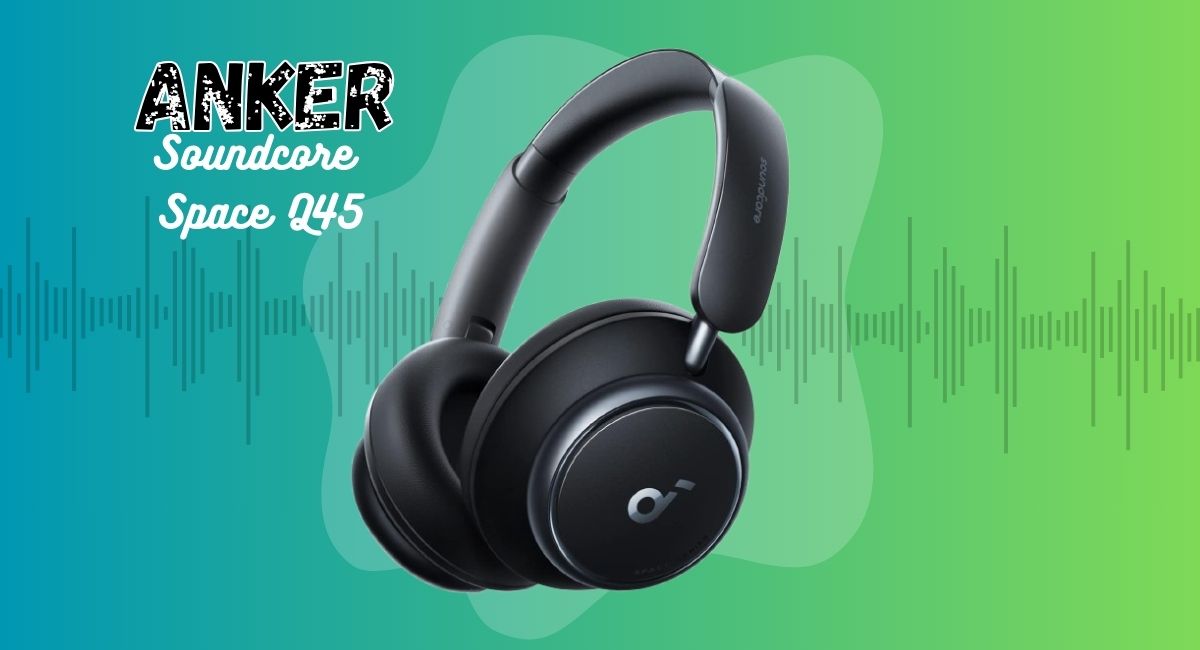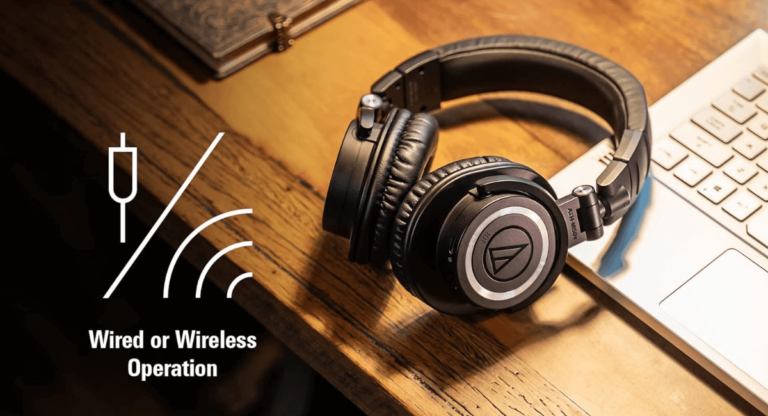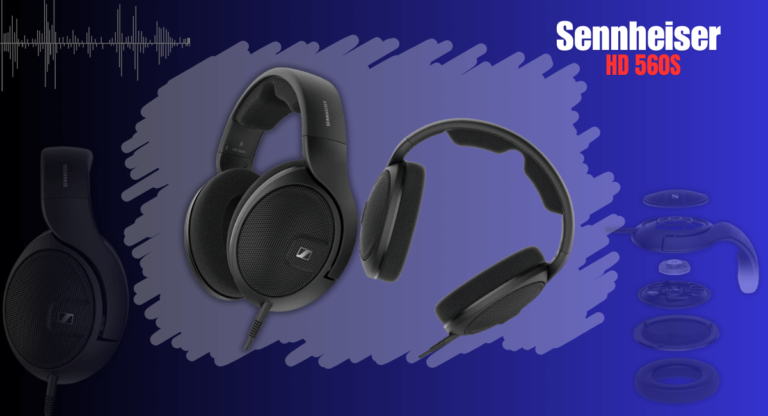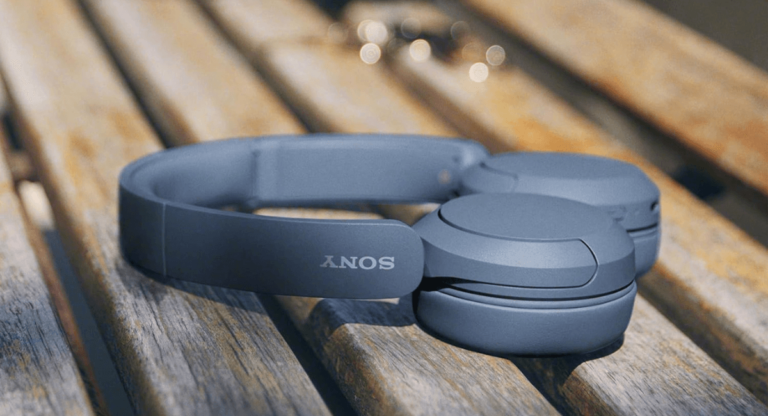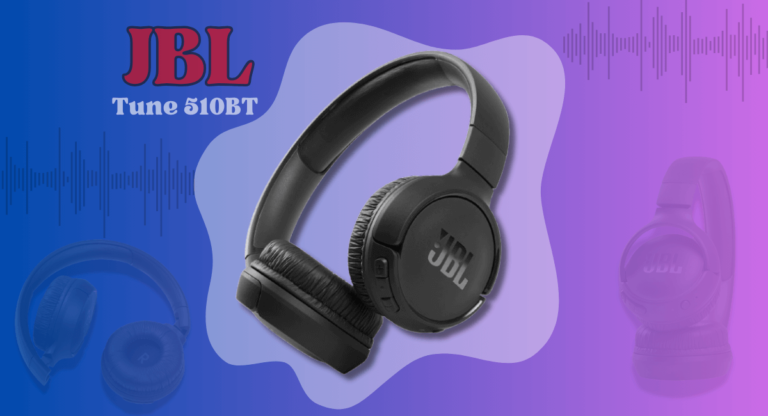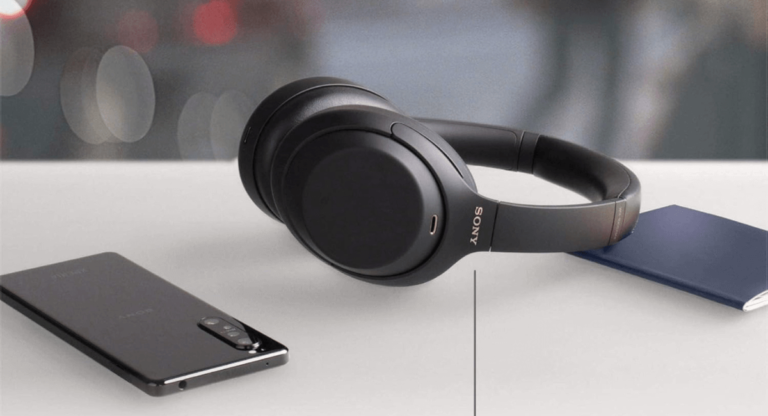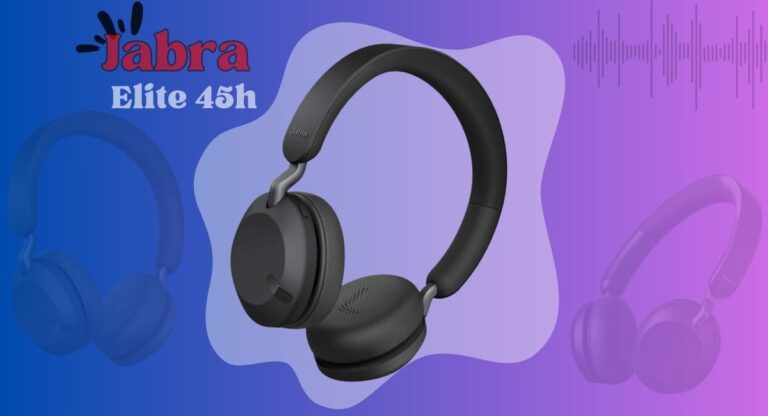Anker Soundcore Space Q45 Review
I recently had another chance to put the Anker Soundcore Space Q45 Wireless headphones through their paces, and I’m excited to share my experience. As someone who values both sound quality and comfort, I was curious to see how these over-ear headphones would perform in real-world scenarios. From their impressive noise-cancelling capabilities to their overall build quality and usability, I tested them in various settings—whether I was at home, commuting, or enjoying some downtime. Here’s a comprehensive look at how the Q45 stacks up in terms of design, sound performance, comfort, and more.
Reasons to Buy
- Excellent noise cancellation for its price
- Comfortable fit for long periods
- Long battery life (up to 50 hours with ANC)
- Solid audio quality with strong bass
- Affordable compared to high-end competitors
Reasons to Avoid
- Limited customization in the app
- Bulky design might not suit everyone
- Mid-range audio clarity could be better
- Call quality is average
Design and Aesthetics
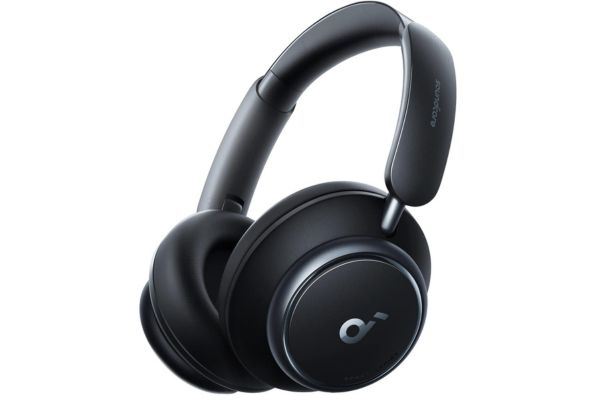
The Anker Space Q45 adaptive anc headphones have a sleek and minimalist design, reminiscent of other models in Anker’s Q series, like the Soundcore Life Q35 Wireless. While they keep things simple, the design still feels modern and refined. The ear cups feature the Anker logo centered on each side, giving the headphones a recognizable but understated look.
The overall finish of the frame is satin, which provides a smooth, matte appearance like Audio-Technica ATH-ANC700BT. However, the outer edge of the ear cups has a glossy touch, adding a bit of contrast and a premium feel to the design. I think it strikes a nice balance between subtle and stylish. These headphones are available in three color options: Black, White, and Blue. Each one looks polished, but I personally find the Black variant to be the most versatile—it works with pretty much any outfit or setting.
In terms of materials, the build is solid, and the headphones feel durable in hand without being too heavy. Despite their robust feel, they don’t come across as bulky, which is a plus for everyday wear. The ear cups are well-padded, which adds to the comfort, especially if you’re planning on using them for long sessions. There’s also a soft padding on the headband that makes them sit nicely on the head without digging in.
The controls are neatly distributed across both ear cups, blending into the design. You won’t notice them too much until you actually start using them. All in all, the design of the Anker Space Q45 feels like it was made with both function and aesthetics in mind. It doesn’t scream for attention, but it looks good and feels well-made, making it a solid choice for anyone looking for wireless, over-ear headphones that can complement their style.
Materials and Build Quality
The build quality of the Anker Soundcore Space Q45 is decent like JBL Tune 770NC, but it’s not without its flaws. These headphones are mostly made of plastic, which is pretty common at this price point. However, they don’t quite give off that premium, sturdy feel that you’d expect from higher-end models like Sony WH-1000XM5. The plastic construction makes them lightweight, which is a plus for portability, but it also means they don’t feel as durable as they could.
One of the biggest things I noticed is the headband. Compared to the Anker Soundcore Life Q35 Wireless, the Q45 has less padding on the headband. This is a bit disappointing, especially if you plan on wearing them for long periods. The lack of cushioning can make them slightly uncomfortable after extended use, which is a shame because the ear cups themselves are pretty well-padded and comfortable. It feels like the headband could have used a bit more attention to detail in terms of comfort.
Another concern with the build is the yokes, which hold the ear cups in place. When storing the headphones, I found that the ear cups don’t lay flat on a surface, which is a little awkward. You also have to be careful when pressing them down, as it feels like you’re putting extra pressure on the yokes. Over time, this could lead to wear and tear, especially if you’re frequently folding and unfolding them to store in their carrying case.
While my unit hasn’t shown any issues so far, I’ve seen reports from other users saying that the hinges or headband have cracked after regular use. That’s something to keep in mind if you’re planning to use these as your everyday headphones.
In terms of overall construction, they remind me of the Sony WH-CH720N Wireless, which has a similar plasticky feel. They don’t feel cheap, but they’re also not the most robust or premium-feeling headphones out there. If you’re someone who’s rough with your gear, you might want to be a little more cautious with how you handle and store these.
Durability and Portability
When it comes to durability and portability, the Anker Soundcore Space Q45 presents a bit of a mixed bag. The build quality feels decent for the most part than Sennheiser HD 560S, but it does lean towards being a bit plasticky. While they seem sturdy enough for everyday use, there have been some reports from users about issues with the hinges and headband cracking over time. So, while they should withstand regular wear and tear, it’s wise to handle them with a bit of care, especially when folding or storing them.
As for portability, these headphones aren’t the most compact option out there like Turtle Beach Stealth 700 Gen 2. They have a bulkier design typical of over-ear headphones, which means they take up a significant amount of space in your bag. Their dimensions—7.6 inches long, 6.2 inches wide, and 2.1 inches high—contribute to this bulkiness. However, Anker has designed them with some practical features to help mitigate this.
The ear cups can swivel to lay mostly flat, which is a nice touch for storage. Additionally, the headphones fold up, making it easier to fit them into a carrying case or backpack.
Despite these folding features, you’ll still need to allocate a decent amount of space for them, and they may not be the best choice for travel if you’re looking for ultra-compact headphones. If you’re someone who frequently takes public transportation or travels often, you might find them a bit cumbersome to carry around.
Comfort and Fit
The comfort and fit of the Anker Soundcore Space Q45 headphones are pretty good overall, but there are some things to keep in mind. First off, they’re lightweight, coming in at about 0.65 lbs, so they don’t feel heavy on your head, which is a big plus, especially if you’re wearing them for long listening sessions. They also don’t clamp too tightly, which makes them feel more relaxed and less fatiguing over time. In fact, the clamping force is just 0.8 lbs, so you won’t get that uncomfortable squeezing feeling that some other headphones can cause.
The ear cup padding is another high point. It feels soft against the skin, making the headphones comfortable to wear for hours. The material is cushy, and it doesn’t get too warm, which is great if you’re someone who tends to wear headphones for extended periods. Its ear cups themselves are a decent size and should fit well over most ears without causing much pressure or discomfort.
However, the headband is where things start to get a bit tricky. The padding on the headband is thinner than what you get with the Anker Soundcore Life Q35 Wireless, and while it’s not a dealbreaker, it can become noticeable after a while. Over time, especially during long listening sessions, the thinner padding can put pressure on the top of your head, which might lead to some discomfort. It’s not unbearable, but if you’re sensitive to that kind of thing, it could be something to watch out for.
When it comes to staying in place, they’re great if you’re sitting still—whether you’re at a desk or lounging on the couch. They don’t shift around much, and they feel secure enough for casual listening. But if you’re thinking about wearing them for more active situations, like jogging or moving around a lot, you might run into some issues. Because they don’t clamp very tightly, they can easily shift or even fall off your head if you’re headbanging or making quick movements. So, they’re probably not the best choice if you’re planning on using them for workouts or while on the go.
Sound Quality
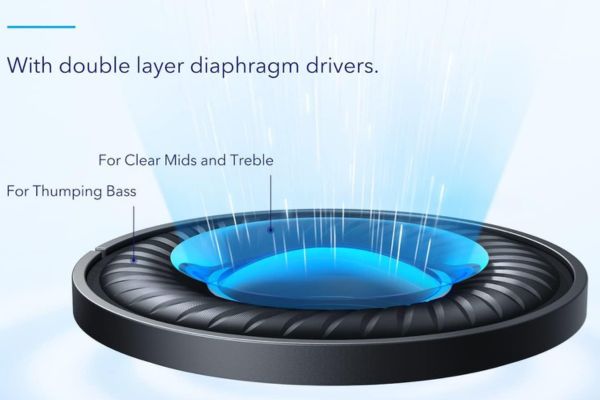
The sound quality of the Anker Soundcore Space Q45 is a mixed bag, but it definitely has its strengths, especially if you enjoy a V-shaped sound profile. What this means is that the bass and treble are emphasized, which works well for certain genres like rock, pop, and even bass-heavy genres like EDM and hip-hop. If you’re someone who likes a lot of thump and rumble in your music, these headphones deliver that in spades. The bass is powerful and energetic, giving songs that extra punch, which is great if you’re into tracks with deep, booming beats.
However, this emphasis on bass does come with some trade-offs. While the bass is strong, it can sometimes overpower other elements of the music, making vocals and midrange instruments sound less detailed.
For instance, vocals can come across as a bit harsh, and certain instruments don’t have the clarity you might expect from more neutral-sounding headphones. It’s not necessarily a dealbreaker, but if you prefer balanced or more detailed audio, you might notice that certain tracks sound a bit too boomy or lack nuance.
The treble is also a bit boosted, which adds brightness to higher-pitched sounds like cymbals and hi-hats. These details come through with crispness, which can be a good thing for genres that rely on sharper sounds. However, again, this can make certain elements sound a bit too forward or piercing, especially if you’re sensitive to high frequencies.
One thing I noticed is that the headphones have a high noise floor, especially when the ANC is set to ‘Adaptive’ or ‘Max.’ The noise floor refers to the faint electronic hiss you can sometimes hear when no music is playing. It’s a bit more noticeable with these headphones than with others I’ve tried, which is a little annoying at first. Over time, you do get used to it, and it’s less noticeable when you’re actually listening to music, but it’s something worth pointing out.
That said, the good news is that the soundcore by Anker space q45 comes with a companion app that has a graphic EQ and several presets, allowing you to tweak the sound to better match your personal preferences. So if you find the bass too strong or the treble a bit too sharp, you can adjust it to get closer to the sound you like. This level of customization is a nice touch and helps balance out some of the issues I had with the default sound profile.
In terms of frequency response consistency, they’re fairly reliable once you find the right fit. The treble can be a little inconsistent at first, but after adjusting the fit and positioning, you’ll get a more consistent sound each time you use them.
ANC Noise Cancellation
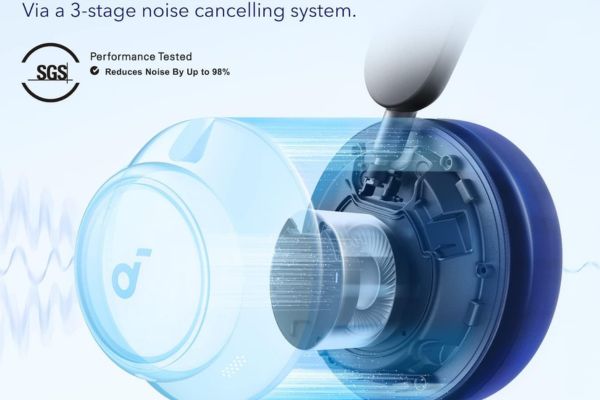
The noise cancellation on the Anker Soundcore Space Q45 is genuinely impressive, especially for its price range. One of the standout features is the adaptive ANC system, which dynamically adjusts to your surroundings to give you the best possible isolation in different environments. Whether you’re on a noisy commute or sitting through a long flight, the Q45 does a great job at cutting down on distracting noises. It’s particularly effective at reducing bass-range sounds, like the deep rumbles of engines or road noise, which is a game changer if you frequently find yourself in those kinds of environments.
In my experience, they do a great job with midrange and higher-pitched sounds as well. The hum of air conditioning units, the chatter of people nearby, or even the sound of a computer fan gets significantly toned down, making it easier to focus on your music or podcasts without distraction. This level of noise isolation is a big improvement over some of Anker’s earlier models, like the Anker Soundcore Space One Wireless, which didn’t quite block out as much noise.
One of the best parts about the soundcore Anker space q45’s noise cancelling is its flexibility. While the adaptive ANC works automatically to give you the best performance based on your surroundings, you can also manually control the ANC via the companion app.
There are five different modes to choose from, each with varying strengths. This is great if you don’t always want full noise cancellation but still want some degree of isolation. For example, when you’re in a quieter place or just need a bit of ambient sound to stay aware of your surroundings, you can choose a less intense ANC mode.
I found that being able to customize the ANC levels to fit the situation is a really useful feature. Sometimes, full ANC can feel a bit overwhelming, especially if you don’t need complete silence, so having these options makes the headphones more versatile.
The Anker Space Q45’s noise cancelling is excellent. Whether you want to block out the world on a noisy commute or just reduce some ambient distractions in a quieter environment, these headphones do the job exceptionally well. The adaptive system is smart, and the manual controls give you more freedom to fine-tune the experience to your liking.
Battery Life
The battery life on the Anker Soundcore Space Q45 is solid, though it doesn’t quite live up to the advertised 50 hours with ANC on. In my experience, the actual battery life is closer to 27.8 hours on a continuous charge, which is still impressive and more than enough for most people to get for a few days without needing a recharge.
The difference in battery life could be due to the volume level or the features you’re using, such as ANC or the microphone. Anker may test at lower volumes, while I usually keep mine at a moderate level, which might explain the variation.
One thing I appreciate is the fast charge time. It takes about 1.8 hours to fully recharge, which isn’t bad at all considering how long they last once charged. If you’re in a pinch, you can plug them in for a little over an hour and have them ready for nearly 28 hours of use again.
There’s also an auto-off timer, which is a great feature for extending the battery life. You can set this in the companion app, and it automatically powers off the headphones when they’re not in use, which helps conserve battery when you forget to turn them off. Unfortunately, you can’t use the headphones while they’re charging, which would have been a nice touch, but the battery life is long enough that this isn’t a major issue.
If you do run out of battery, there’s still an option for passive playback via the included TRS cable. This is super convenient because it means you’re never completely out of luck, even if you forget to charge them.
the battery life on the Anker Space Q45 is great for long listening sessions, and the quick charge time is a nice bonus. While it doesn’t hit the full 50-hour mark as advertised, the nearly 28 hours I got out of them is more than sufficient for most users, and features like the auto-off timer make managing the battery even easier.
Connectivity and Usability
The connectivity and usability of the Anker Soundcore Space Q45 are pretty versatile, making them a solid option for a wide range of use cases. One of the standout features is their Bluetooth 5.3 compatibility, which provides a strong, stable connection.
You can pair these headphones with up to two devices at the same time, thanks to their multi-device pairing feature. This is super convenient if, like me, you’re someone who likes to switch between a phone and a laptop without having to constantly disconnect and reconnect. However, it’s important to note that you can’t use multi-device pairing when you’re using LDAC, which is a bit of a limitation if you’re looking for the highest-quality sound.
When it comes to range, the Bluetooth connection is impressive. I was able to get up to around 334 feet (102 meters) of line-of-sight range before noticing any connection dropouts, which is much better than most other wireless headphones in this price range. So, if you’re someone who likes to move around while listening to music or taking calls, you’ll probably appreciate this extended range.
However, one thing to keep in mind is that there can be some latency issues, especially on PCs. When streaming video or gaming, the audio and visuals may fall out of sync due to higher latency. It’s most noticeable when using the SBC codec, with around 250 ms of delay. If you’re using the LDAC codec, which offers higher sound quality, the latency is even higher at 403 ms, but this won’t be a big issue if you’re just listening to audio or music. Latency really depends on the device and the apps you’re using, so if you’re mostly into streaming video or gaming, you might want to be aware of this.
As for analog connectivity, the Q45 noise cancelling headphone comes with a detachable 1/8″ TRS to 1/8″ TRS cable, which lets you use them in wired mode. This is great for when you run out of battery or just want a more traditional listening experience. That said, the analog connection only supports audio, so you won’t be able to use the built-in microphone in wired mode. There’s also a USB-C charging port, and the headphones come with a USB-A to USB-C cable for charging.
The Anker Soundcore app is another strong point in terms of usability. It allows you to control ANC, switch between transparency mode and normal mode, and even adjust the noise cancelling strength with five different levels. The app also includes an 8-band graphic equalizer with presets, giving you a lot of flexibility to customize the sound to your liking. You can even set a volume limit or safe volume, which is a nice touch if you’re concerned about long-term hearing health.
Mic Performance and Call Quality: 75/100
The microphone performance on the Anker Soundcore Space Q45 is a bit of a mixed bag. When it comes to call quality, the mic is decent, but not the best I’ve experienced. In quieter environments, your voice comes through clearly enough for the person on the other end to understand you, but it can sound a bit thin and lacking depth.
There’s a noticeable lack of richness in how your voice is transmitted—it sounds somewhat dark and less natural, especially compared to other headphones like the Anker Soundcore Life Q35 Wireless or the Sony ULT WEAR Wireless. It’s not a dealbreaker for casual calls, but it’s something to be aware of if you’re particular about mic clarity.
Where the Q45’s mic really shines, though, is in noisy environments. Its noise-handling performance is impressive. Whether you’re taking a call on a busy street, in a cafe, or even on a noisy subway, the mic does a great job at minimizing background noise so your voice remains clear. The integrated noise gate keeps unwanted sounds low, so you don’t have to shout over the ambient noise. I found that even with the hustle and bustle around me, the person I was speaking to could hear me without too much difficulty, which is a big plus if you often find yourself in noisy places.
One thing to note is that the mic isn’t detachable, and there’s no boom option, which means you’re relying solely on the integrated mic. It’s perfectly fine for everyday calls, but for professional use or situations where top-notch mic quality is essential, it might fall a little short.
In terms of performance, the microphone’s noise suppression is quite effective, but the sound quality of your voice isn’t as full or natural as you might get with higher-end models. If clear communication in noisy environments is a priority, these headphones do a great job. If you’re looking for studio-level clarity in your voice, however, they might not meet those expectations.
Gaming Performance
In terms of gaming performance, the Anker Soundcore Space Q45 Wireless headphones are a mixed bag. While these headphones are primarily designed for music and multimedia use, I decided to put them to the test during gaming sessions to see how they hold up.
First, let’s talk about latency. Since these headphones rely on Bluetooth (even with the latest Bluetooth 5.3), there is a noticeable delay when playing fast-paced, competitive games like shooters or racing titles. This delay affects real-time responses, making it hard to stay competitive in games that require quick reflexes. That said, for casual or story-driven games where split-second timing isn’t critical, the latency isn’t as noticeable and can still offer an enjoyable experience.
On the positive side, the sound quality remains excellent. The 40mm drivers deliver immersive audio, with a strong bass response and clear mids and highs. In-game explosions, sound effects, and environmental sounds feel full and rich, which enhances the overall experience, especially in games with great sound design like open-world adventures or RPGs. However, the soundstage isn’t as wide as you would expect from dedicated gaming headsets, meaning spatial awareness (like hearing enemy footsteps from precise directions) can feel a bit lacking.
The ANC (active noise cancellation) works well even in gaming environments. It effectively blocks out external distractions, allowing you to focus on the game. However, just like with music, turning ANC on slightly impacts the sound quality, which can be noticeable in certain in-game audio scenarios.
Lastly, the built-in microphones, while adequate for phone calls or casual chats, aren’t as high-quality as you’d expect from gaming headsets. During voice chats, my voice sounded a little distant, and noise isolation wasn’t as clean as some of the dedicated gaming headsets with boom mics.
Final Verdict
After using the Anker Soundcore Space Q45 Wireless for a few weeks, I can confidently say these headphones are an impressive option for their price. One of the standout features is the active noise cancellation (ANC), which performs exceptionally well. Whether I was commuting on a noisy train or working in a busy café, the ANC effectively blocked out most background noise, making it easier to focus or enjoy music. While it doesn’t quite match the performance of high-end models like the Sony WH-1000XM5, for the price, it holds its own remarkably well.
The sound quality is balanced and rich. The bass is powerful, but it doesn’t overpower the mids and highs, creating a well-rounded audio experience. I tested these with various genres, from rock to classical, and everything sounded crisp and detailed. The headphones also support LDAC, which delivers even better sound quality when paired with compatible devices.
Comfort is another strong point. The ear cushions are soft and provide a good seal without feeling too tight. I wore these for hours at a time during long work sessions, and they never felt uncomfortable or heavy on my head. The build quality feels solid too, with a mix of durable plastic and metal accents that give them a premium feel.
Battery life is stellar. I got close to 50 hours of playback with ANC on, which is very close to Anker’s claims. Even better, with a quick 5-minute charge, I was able to get around 4 hours of playback, which is perfect for when you’re in a rush.
If there’s any downside, it’s that the touch controls are a bit tricky to get used to. They’re responsive, but there’s a slight learning curve to remembering all the gestures. Also, the ANC, while great, slightly alters the audio when turned on, though it’s a minor trade-off for the level of noise cancellation you get.
How did we test this Anker headphone?
To test the Anker Soundcore Space Q45 headphones, we started by putting them through a comfort check. We wore them throughout the day during different activities—whether working at the desk, going for a walk, or simply relaxing at home. After a few hours, we could really gauge how they felt. No one likes headphones that get uncomfortable after an hour, so we paid close attention to any pressure on the ears or head. The snugness during movement was also something we checked.
For the noise cancellation, we took the headphones into different real-world environments. First, we wore them while walking down a busy street to see how well they blocked out city noise. We then tested them in a noisy café and on public transport, switching between the active noise cancellation modes. This gave us a clear idea of how well they filtered out distractions versus when ANC was off.
When it came to sound quality, we ran them through a playlist that covered everything—bass-heavy tracks, podcasts, and more acoustic music. This helped us see how balanced the sound was, especially when switching genres. We wanted to experience the highs, mids, and lows to know if the audio quality was up to par.
Finally, battery life was tested by using the headphones continuously with noise cancellation on to see how long they really lasted. The manufacturer’s claims were compared to our actual usage, including some long listening sessions without needing to recharge.

